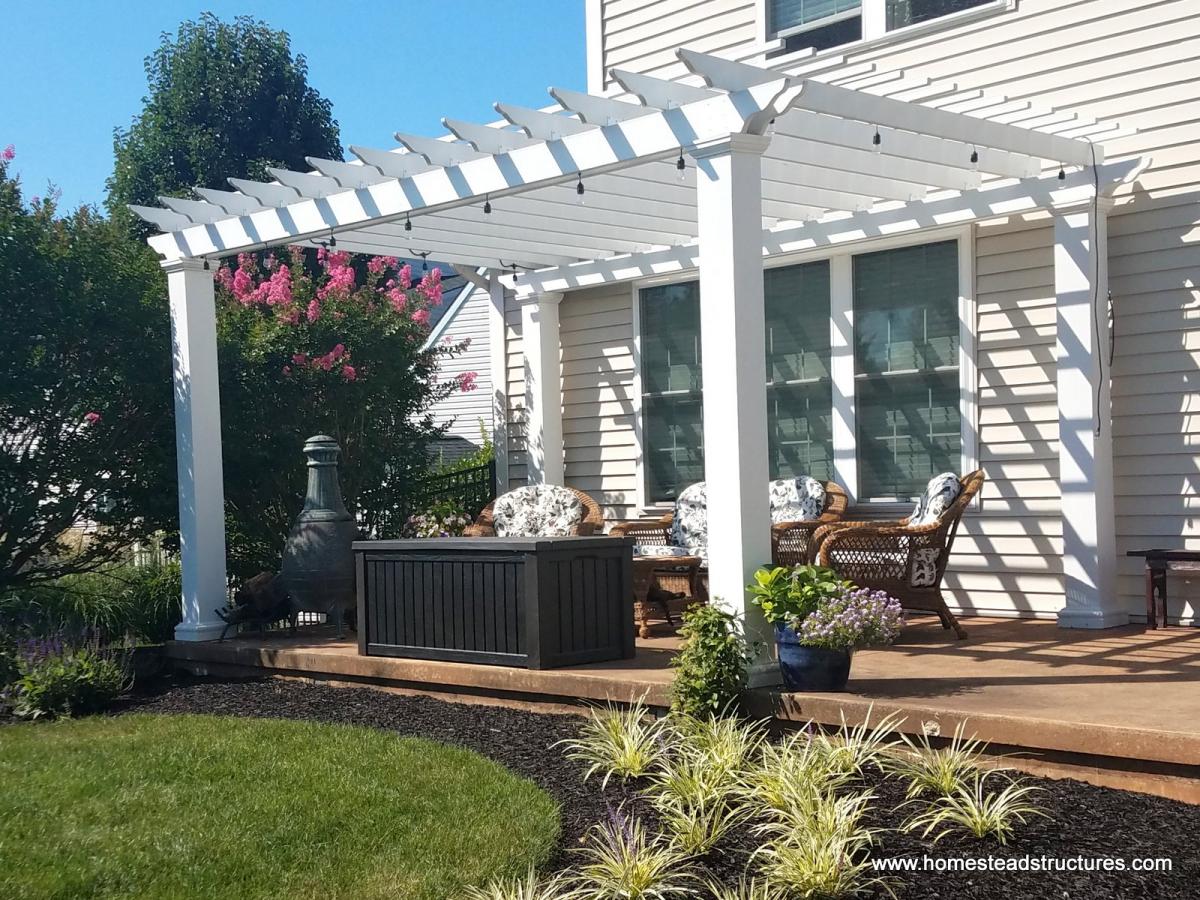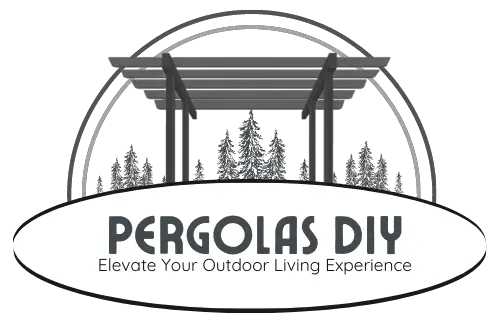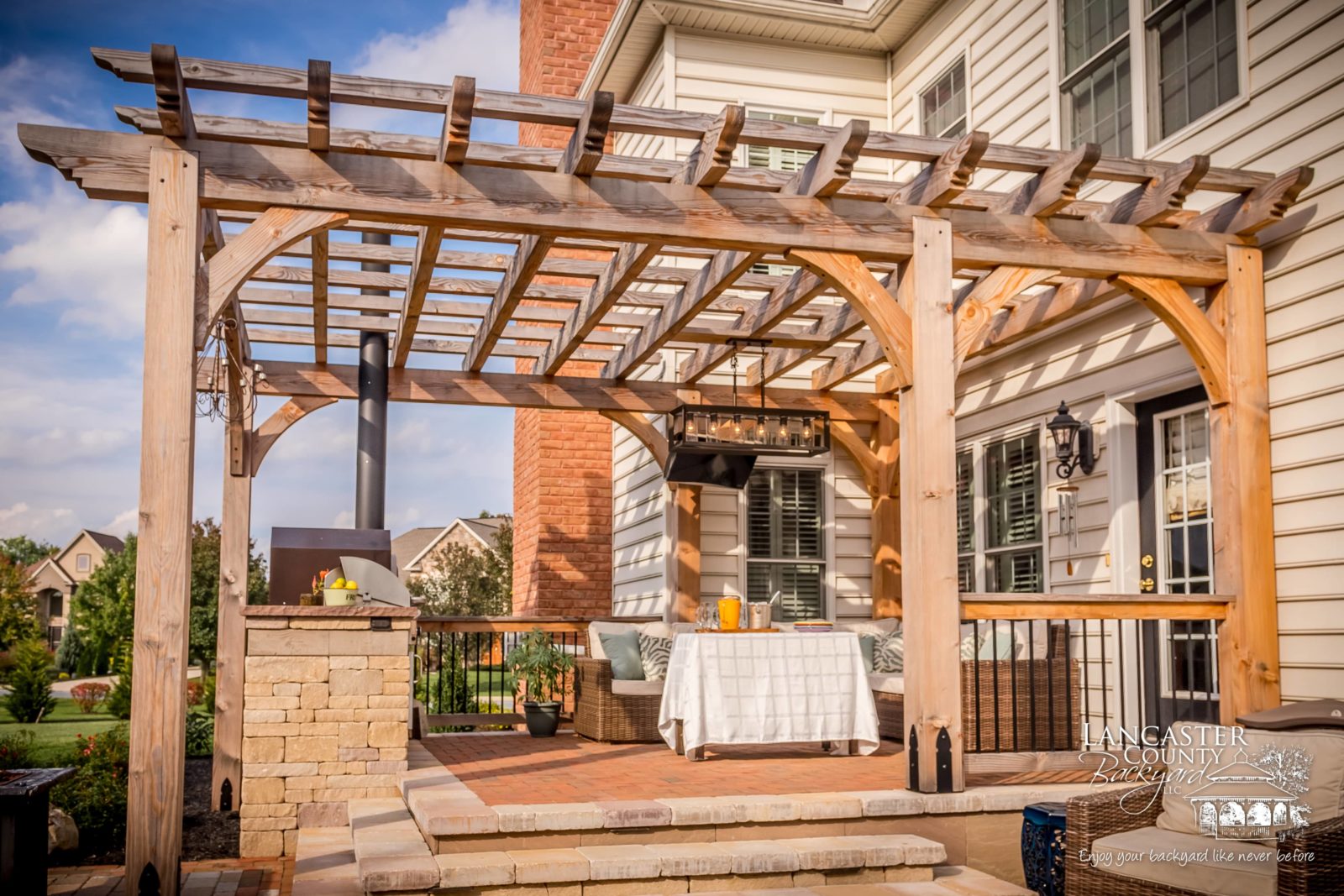A pergola works by providing a shaded outdoor space through the use of an open-roof structure supported by columns or posts. The structure is typically made of wood, metal, or vinyl, and the open-roof design allows for ventilation and natural light while still offering protection from the sun.
Additionally, pergolas can be customized with drapes, curtains, or plants for added privacy and aesthetic appeal. The open design also allows for flexibility in terms of furniture placement and outdoor activities, making it a versatile addition to any outdoor space.
Whether attached to a building or stand-alone, a pergola creates an inviting and cozy atmosphere for relaxation and entertaining.

Credit: www.homesteadstructures.com
Function Of A Pergola
How Does A Pergola Work?
A pergola is a versatile outdoor structure that not only enhances the aesthetic appeal of your outdoor space but also serves a functional purpose. By adding a pergola to your backyard or garden, you can create a beautiful and inviting space where you can relax, entertain, or simply enjoy the outdoors.
In this section, we will explore the definition and purpose of a pergola, how it enhances outdoor spaces, and the key benefits of installing one.
Definition And Purpose Of A Pergola:
- A pergola is an open-air structure consisting of vertical posts that support crossbeams and an open lattice roof.
- It is designed to provide partial shade, define a space, and add architectural interest to outdoor areas.
- The primary purpose of a pergola is to create a comfortable outdoor living space that allows you to enjoy the beauty of nature while providing protection from the elements.
Enhancing Outdoor Spaces With A Pergola:
- A pergola acts as a focal point, adding visual interest and enhancing the overall aesthetic appeal of your outdoor space.
- It provides a sense of privacy and seclusion by creating a defined area separate from the rest of the yard.
- With its open design, a pergola allows for ample airflow and natural light, creating a pleasant and inviting atmosphere.
- You can customize your pergola by adding curtains, drapes, or climbing plants, further enhancing its beauty and functionality.
Key Benefits Of Installing A Pergola:
- Increased living space: A pergola expands your living area, providing an additional space for entertaining guests or enjoying quality time with your family.
- Protection from the sun: The open lattice roof of a pergola provides partial shade, shielding you from the harsh rays of the sun while still allowing for some sunlight.
- Versatility: Pergolas can be customized to suit your specific needs and preferences. You can add features like lighting, fans, or outdoor furniture to make it a more functional and comfortable space.
- Added value to your home: Installing a pergola can increase the value of your property by creating a unique and desirable outdoor living area.
By understanding the function of a pergola and its numerous benefits, you can transform your outdoor space into a captivating and relaxing oasis that will be the envy of your neighbors. So, why wait? Consider adding a pergola to your backyard and enjoy the many advantages it offers.
Structural Components Of A Pergola
Pergolas have become a popular addition to outdoor spaces, providing both functionality and elegance to any backyard or garden. These stylish structures not only add shade and protection from the elements, but they also create a beautiful focal point for relaxation and entertaining.
If you’re curious about how a pergola works and its structural components, you’ve come to the right place. In this section, we’ll delve into the main framework of a pergola, the materials used in its construction, and explore different types of pergolas to suit your personal style and needs.
Main Framework Of A Pergola:
- Posts and columns: The main vertical supports of a pergola are the posts or columns, which are typically made of sturdy materials such as wood, metal, vinyl, or fiberglass. These posts are strategically positioned to provide stability and support for the entire structure.
- Beams and crossbeams: Connecting the posts horizontally are the beams and crossbeams. These strong horizontal elements provide the framework for the roof of the pergola, offering both support and stability.
- Rafters and purlins: The rafters and purlins are additional horizontal elements that are often added to the top of the pergola. They not only provide additional support but also add architectural interest and beauty to the overall design.
Materials Used In Pergola Construction:
- Wood: Traditional and natural, wood is a popular material used in pergola construction. It offers a classic and rustic appeal while being durable and sturdy. Common types of wood used include cedar, redwood, and pressure-treated pine.
- Metal: Metal pergolas are known for their strength and durability. They are commonly constructed using materials such as aluminum or steel, offering resistance to weather elements and requiring less maintenance over time.
- Vinyl: Vinyl pergolas have gained popularity due to their low maintenance and longevity. They are resistant to rot, warping, and insects, making them a practical choice for homeowners seeking a hassle-free option.
- Fiberglass: Fiberglass pergolas are known for their lightweight yet strong nature. They offer flexibility in terms of design and are often used in modern or contemporary structures.
Other Options:
- Apart from wood, metal, vinyl, and fiberglass, other materials such as concrete, stone, and even bamboo can be used to construct pergolas, providing unique and custom options to suit individual preferences.
Types Of Pergolas:
- Traditional pergolas: These pergolas feature a classic design with an open framework and are often constructed with natural materials such as wood. They exude a timeless charm and are suitable for various outdoor settings.
- Modern pergolas: Designed with clean lines and a contemporary aesthetic, modern pergolas often incorporate sleek materials like metal or fiberglass. They can be customized to suit specific architectural styles and preferences.
- Attached pergolas: As the name suggests, attached pergolas are connected to a pre-existing structure such as a building or a wall. They create an extension of the indoor space and can provide shade and additional living areas.
- Freestanding pergolas: These pergolas are not attached to any existing structure and are often placed in open spaces within the backyard or garden. They offer more flexibility in terms of positioning and are perfect for creating separate outdoor entertaining areas.
By understanding the structural components, materials, and various types of pergolas available, you can make an informed decision when considering this versatile addition to your outdoor space. Whether you prefer a traditional or modern design, a pergola is sure to enhance the beauty and functionality of your backyard oasis.
Design Considerations And Options
A pergola is more than just a simple outdoor structure; it’s a beautiful addition to any space that can transform your backyard into a peaceful oasis. When it comes to designing a pergola, there are several key considerations and options to keep in mind.
From choosing the right location for optimal use to customizing the design to suit your aesthetic preferences, let’s explore the various design elements that go into creating the perfect pergola.
Choosing The Right Location For A Pergola
- Consider the purpose: Determine how you plan to use your pergola. For example, if you want to create a cozy seating area, consider placing it near the patio or poolside.
- Sun exposure: Pay attention to the sun’s path throughout the day to find the ideal location that offers sufficient shade or sun exposure.
- Accessibility: Ensure that the location is easily accessible from your home and other outdoor areas to maximize convenience.
Determining The Ideal Pergola Size And Dimensions
- Assess available space: Measure the area where you intend to install the pergola to determine the appropriate size and dimensions.
- Consider the function: Depending on your needs, you can opt for a compact pergola for intimate gatherings or a larger one for hosting events and parties.
- Height and clearance: Take into account the height restrictions and any overhead obstructions, such as tree branches or power lines, to choose the right height for your pergola.
Customization Options For Pergola Design
- Material selection: Choose from a variety of materials such as wood, metal, or vinyl, each offering their unique aesthetic appeal and durability.
- Roofing options: Explore different roofing materials such as lattice, slats, or solid panels to determine the level of shade and protection you desire.
- Privacy features: Enhance your pergola’s privacy with options like curtains, blinds, or decorative screens for a more intimate outdoor experience.
Styling And Finishes
- Paint or stain: Add your personal touch by painting or staining the pergola to match your existing outdoor décor or create a stand-out focal point.
- Color coordination: Consider coordinating the color palette of your pergola with the surrounding landscape or furniture to achieve a cohesive look.
- Finishing touches: Enhance the overall aesthetic appeal with decorative elements such as finials, corbels, or trim details that complement your chosen style.
Decorative Elements
- Greenery and vines: Incorporate climbing plants and vines along the sides of your pergola to create a natural, inviting atmosphere.
- Lighting fixtures: Install outdoor lighting fixtures like fairy lights, lanterns, or sconces to enhance the ambiance and extend the usability of your pergola into the evening.
- Furniture and accessories: Complete the look and functionality of your pergola by selecting suitable furniture, cushions, and accessories that add comfort and style.
Integration With Landscape And Other Structures
- Seamless integration: Blend your pergola seamlessly with your existing landscape design, incorporating elements such as walkways, garden beds, or water features.
- Connection to other structures: Consider connecting your pergola to other outdoor structures like patios, decks, or gazebos to create a cohesive outdoor living space.
Remember, the design considerations and options for a pergola are endless. Feel free to unleash your creativity and personalize your pergola design based on your preferences, creating a truly unique outdoor retreat.
Installation And Maintenance
A pergola is not only a stylish addition to any outdoor space but also serves a functional purpose. Understanding how a pergola works is essential for the successful installation and maintenance of this structure. In this section, we will delve into the key steps involved in installing a pergola and provide tips for its ongoing maintenance.
Steps Involved In Installing A Pergola
Installing a pergola involves various key steps, including site preparation, foundation and anchoring, as well as assembly and construction. Let’s take a closer look at each of these steps:
- Site preparation: Before installing a pergola, it is important to assess the space and ensure it is suitable for the structure. This includes clearing the area of any debris, leveling the ground, and marking the desired location for the pergola.
- Foundation and anchoring: A sturdy foundation is crucial for the stability and longevity of a pergola. Depending on the chosen design and materials, options for foundations can range from concrete footings to pre-cast bases. Anchoring the pergola securely to the ground is also essential, preventing it from shifting or toppling over in strong winds.
- Assembly and construction: Once the foundation is in place, it’s time to assemble and construct the pergola. This typically involves following the manufacturer’s instructions and connecting the various components such as posts, beams, and rafters. It’s important to ensure proper alignment and secure all connecting points for a structurally sound pergola.
Tips For Ongoing Pergola Maintenance
To keep your pergola in optimal condition, regular maintenance is necessary. Here are some tips to help you with the cleaning, upkeep, and addressing any repairs or replacements that may arise:
- Cleaning and upkeep: Periodically clean your pergola by scrubbing off dirt, debris, and any stains using mild soap and water. Regularly inspect the structure for signs of wear or damage, such as chipped paint or loose screws, and address them promptly. Additionally, trim any overhanging branches or vines that could potentially damage the pergola.
- Repairs and replacements: Over time, certain components of the pergola may require repair or replacement. This could include replacing damaged parts, repainting or staining the wood, or securing loose connections. It’s important to regularly inspect the pergola and address any maintenance issues to prevent further damage and ensure its longevity.
- Pest prevention: Pests, such as termites or ants, can cause damage to the wooden components of a pergola. To prevent pest infestations, consider treating the wood with appropriate protective coatings or using natural remedies. Regularly inspect the structure for signs of pest activity and take necessary steps to eliminate them.
By following these installation and maintenance tips, you can ensure that your pergola remains a beautiful and functional addition to your outdoor space for years to come. Regular care and upkeep of the pergola will not only extend its lifespan but also create an inviting space for relaxation and enjoyment.
Frequently Asked Questions On How Does A Pergola Work
How Does A Pergola Work In Providing Shade?
A pergola works by providing shade through its open-roof design and cross-beam pattern. The beams create partial shade, allowing some sunlight to filter through while reducing direct exposure. Additionally, you can add climbing plants or retractable shades to further enhance the shade provided by the pergola.
Does A Pergola Add Value To A Home?
Yes, a pergola can add value to a home. It not only enhances the aesthetic appeal of your outdoor space but also offers additional functionality. Pergolas provide a designated area for relaxation, entertainment, and dining, making your property more appealing to potential buyers.
Can A Pergola Support Climbing Plants?
Absolutely! Pergolas are perfect for supporting climbing plants such as vines, roses, or wisteria. The open lattice or cross-beam design of a pergola serves as a natural framework for the plants to climb, creating a beautiful and lush green canopy.
How Do Pergolas Provide Ventilation?
Pergolas provide ventilation through their open-roof structure. The open beams and lattice design allow air to flow freely, creating a cool and breezy atmosphere. This natural ventilation is particularly beneficial during hot summer days, making your outdoor space more comfortable.
Can I Install A Pergola Myself Or Should I Hire A Professional?
While it is possible to install a pergola yourself, it is recommended to hire a professional for a proper and secure installation. Professionals have the experience and tools to ensure that the pergola is correctly anchored, structurally sound, and meets local building codes, ensuring your safety and the longevity of the pergola.
Conclusion
To sum it up, a pergola is a versatile outdoor structure that not only adds aesthetic appeal to your space but also provides functional benefits. Its open-roof design allows for ventilation and natural light, making it an ideal choice for enjoying the outdoors while still having some protection from the elements.
Whether you use it to create a cozy seating area, host gatherings, or even grow climbing plants, the possibilities are endless. Pergolas can be customized to fit any size or style preference, making them a perfect addition to any home or garden.
With the right materials and proper installation, a pergola can be a long-lasting and worthwhile investment that enhances your living space and increases your property value. So why wait? Consider adding a pergola to transform your outdoor area into a tranquil oasis that you can enjoy year-round.

